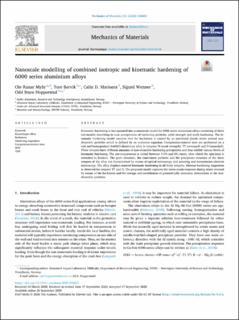Nanoscale modelling of combined isotropic and kinematic hardening of 6000 series aluminium alloys
Peer reviewed, Journal article
Published version
Permanent lenke
https://hdl.handle.net/11250/2689483Utgivelsesdato
2020Metadata
Vis full innførselSamlinger
- Publikasjoner fra CRIStin - SINTEF AS [5801]
- SINTEF Industri [1566]
Sammendrag
Kinematic hardening is incorporated into a nanoscale model for 6000 series aluminium alloys consisting of three sub-models describing in turn precipitation of hardening particles, yield strength and work hardening. The kinematic hardening model assumes that the backstress is caused by an unrelaxed plastic strain around non-shearable particles which is defined by an evolution equation. Compression-tension tests are performed on a cast and homogenized AA6063 aluminium alloy in tempers T6 (peak strength), T7 (overaged) and O (annealed). These tempers have different amounts of non-shearable hardening precipitates and thus exhibit various levels of kinematic hardening. The pre-compression is varied between 0.5% and 6% strain, after which the specimen is stretched to fracture. The grain structure, the constituent particles and the precipitate structure of the three tempers of the alloy are characterized by means of optical microscopy and scanning and transmission electron microscopy. The alloy displays marked kinematic hardening in all three tempers, whereas hardening stagnation is observed for tempers T7 and O. The proposed model captures the stress-strain response during strain reversal by means of the backstress and the storage and annihilation of geometrically necessary dislocations at the non-shearable particles.

